| Pages:
1
2 |
Magpie
lab constructor
    
Posts: 5939
Registered: 1-11-2003
Location: USA
Member Is Offline
Mood: Chemistry: the subtle science.
|
|
Martius Yellow - fun with dyes
Using 5g of the homemade 1-naphthol that I reported on yesterday, I made Martius Yellow, a dye. I used the procedure found in Louis Fieser's book
Experiments in Organic Chemistry, 3rd ed, rev., (1957), pp. 234-236. My yield was 4.6g compared to Fieser's 7.7g, 88.5% yield.
The procedure was to sulfonate the 1-naphthol at the 2, 4 positions, then convert this disulfonate to 2,4 dinitro. This is then converted to a 2,4
diammonium chloride salt. This is shown below in dried form:
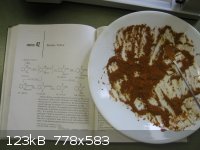
Martius Yellow
This salt will be used to make the remaining several dyes in Fieser's series.
In the past I have also made methyl orange, malachite green, and fluorescein dyes. They are fun to make, providing pleasing colors, and some can be
useful as pH indicators for titrations. It is also quite educational to see how easily contamination is spread during one's lab work. The evidence is
everywhere.
The single most important condition for a successful synthesis is good mixing - Nicodem
|
|
|
Sublimatus
Hazard to Others
  
Posts: 108
Registered: 8-6-2011
Member Is Offline
Mood: No Mood
|
|
Quote: Originally posted by Magpie  | | It is also quite educational to see how easily contamination is spread during one's lab work. The evidence is everywhere. |
Ain't that the truth. Of all chemicals, intense fluorescent dyes are high on my list of nasty things I don't enjoy working with. They get under
gloves, contaminate your glass and other work for weeks, and if you let a solution of it bump in a rotavap... oh boy.
Alright... they're not that bad, but it certainly is eyeopening to find out just how present chemical residues really are in the lab and on
your person. 
|
|
|
Paddywhacker
Hazard to Others
  
Posts: 478
Registered: 28-2-2009
Member Is Offline
Mood: No Mood
|
|
What you mean is that you don't like being able to see the contamination. The same level of contamination exists whether or not you can see it.
|
|
|
Morgan
International Hazard
    
Posts: 1660
Registered: 28-12-2010
Member Is Offline
Mood: No Mood
|
|
To some extent even something as common as KMNO4 is like that when rinsing off glasswear. The tiniest flecks produce deep purple traces when water
touches them. And while certainly not good to breathe, just grinding some in a mortar and pestle you can detect some contamination in the air, a
slightly sweet smell. When I would wash the mortar and pestle with the garden hose, there was an explosion of purple from the smallest remains.
|
|
|
Magpie
lab constructor
    
Posts: 5939
Registered: 1-11-2003
Location: USA
Member Is Offline
Mood: Chemistry: the subtle science.
|
|
Here's a couple more pictures from today's efforts. I'm sure glad I don't have to do this series in 2 ea 3-4hr lab periods as did Fieser's students!
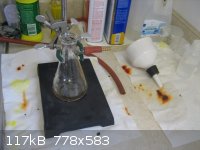
just another day at the dye lab
Attachment: phpsq28xN (95kB)
This file has been downloaded 929 times
II and IV of Fieser's Marius Yellow dye series
II is 2-amino-1,4-naphthoquinonimine hydrochloride. IV is 2,4-diacetylamino-1-naphthol. These will be converted to still yet other dyes.
BTW sodium hydrosulfite is available OTC from DanielSmith, Inc.
The single most important condition for a successful synthesis is good mixing - Nicodem
|
|
|
Magpie
lab constructor
    
Posts: 5939
Registered: 1-11-2003
Location: USA
Member Is Offline
Mood: Chemistry: the subtle science.
|
|
Today I made dyes III and VII from dye II:
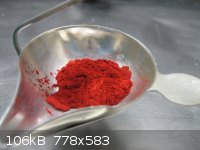
II. 2-amino-1,4-naphthoquinonimine HCl
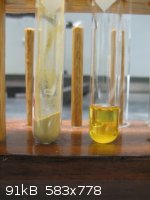
III. 2-amino-1,4-naphthoquinonimine diacetate
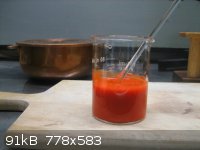
VII. 4-amino-1,2-naphthoquinone
There are just two more dyes to make: V and VI from IV. II is my favorite so far. Here's another picture of VII, recrystallized into needles from
hot water:
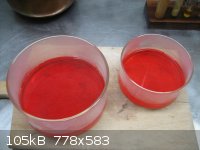
The single most important condition for a successful synthesis is good mixing - Nicodem
|
|
|
AndersHoveland
Hazard to Other Members, due to repeated speculation and posting of untested highly dangerous procedures!
    
Posts: 1986
Registered: 2-3-2011
Member Is Offline
Mood: No Mood
|
|
Quote: Originally posted by Magpie  | | The procedure was to sulfonate the 1-naphthol at the 2, 4 positions, then convert this disulfonate to 2,4 dinitro. |
How is the sulfonate converted to nitro ?
|
|
|
Magpie
lab constructor
    
Posts: 5939
Registered: 1-11-2003
Location: USA
Member Is Offline
Mood: Chemistry: the subtle science.
|
|
Actually, I misspoke there. It was a disulfonic acid that was converted to a dinitro. It's a two step process. First the 1-napthol is treated with
con sulfuric to make 2,4 disulfonic acid-1-naphthol. In the second step that product is treated with con nitric acid to form 2,4 dinitro-1-naphthol
(Martius Yellow).
This 2-step process has me a little confused. I've never seen it before. My education and experience is that of using nitrating acid, ie, mixed
H2SO4 and HNO3, to install nitro groups on an aromatic compound.
[Edited on 18-3-2013 by Magpie]
The single most important condition for a successful synthesis is good mixing - Nicodem
|
|
|
Lambda-Eyde
National Hazard
   
Posts: 857
Registered: 20-11-2008
Location: Norway
Member Is Offline
Mood: Cleaved
|
|
Quote: Originally posted by Magpie  |
This 2-step process has me a little confused. I've never seen it before. My education and experience is that of using nitrating acid, ie, mixed
H2SO4 and HNO3, to install nitro groups on an aromatic compound.
|
IIRC the same technique is used for installing the final nitro group in TNT (trinitrotoluene), but oleum is used instead. I think the idea is that the
ring is so deactivated by the two nitro groups that using mixed acids is useless, while sulfonation with oleum occurs more readily. The resulting
sulfonic acid is then subjected to nitric acid, replacing the -OSO<sub>2</sub>OH moiety with a nitro.
[Edited on 18-3-2013 by Lambda-Eyde]
This just in: 95,5 % of the world population lives outside the USA
You should really listen to ABBAPlease drop by our IRC channel: #sciencemadness @ irc.efnet.org
|
|
|
Magpie
lab constructor
    
Posts: 5939
Registered: 1-11-2003
Location: USA
Member Is Offline
Mood: Chemistry: the subtle science.
|
|
Here's photos of the last 2 dyes, V and VI. V was made from IV and VI was made from V.
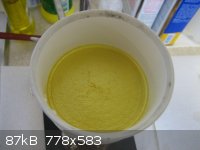
V. 2-acetylamino-1,4-naphthoquinone
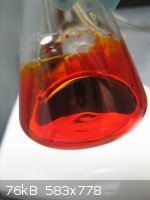
VI. 2-amino-1,4-naphthoquinone
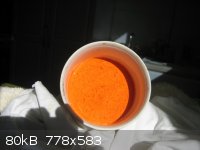
VI. in water
My son, who is an artist, was impressed with the intensity of some of these dyes. He asked if any of them could be used as pigments and were light
fast. I couldn't answer him but suspect that since, with the exception of Martius Yellow, they don't have commercial names (that I am aware of) they
probably aren't useful for oil painting. Anyone know about this?
The single most important condition for a successful synthesis is good mixing - Nicodem
|
|
|
DraconicAcid
International Hazard
    
Posts: 4278
Registered: 1-2-2013
Location: The tiniest college campus ever....
Member Is Offline
Mood: Semi-victorious.
|
|
Have him try them. Make a simple painting with them, stick it in the sun for a month or two, see if there is any degradation.
Please remember: "Filtrate" is not a verb.
Write up your lab reports the way your instructor wants them, not the way your ex-instructor wants them.
|
|
|
CuReUS
National Hazard
   
Posts: 928
Registered: 9-9-2014
Member Is Offline
Mood: No Mood
|
|
magpie
i have finished making the 2,4 dinitro naphtol.but i am having problems with recrystallization(tried with ethanol,but the dye wont dissolve
completely) and after the ethanol has evaporated away, all that is left a dry yellow powder,far from fieser's yellow needles.also for the reduction to
the diamino,could you use a reagent other than Na2S2O4 (according to fieser,we could use tin/hcl but the purification will be difficult and i wont
have much product left(i started with 2g 1-napthol).could we use hypo(Na2S2O3).the mechanism of the reduction is a free radicle SO2 i think,i will try
to get the article
|
|
|
Magpie
lab constructor
    
Posts: 5939
Registered: 1-11-2003
Location: USA
Member Is Offline
Mood: Chemistry: the subtle science.
|
|
Quote: Originally posted by CuReUS  | magpie
i have finished making the 2,4 dinitro naphtol.but i am having problems with recrystallization(tried with ethanol,but the dye wont dissolve
completely) and after the ethanol has evaporated away, all that is left a dry yellow powder,far from fieser's yellow needles. |
Looking back in my notes it looks like I did not convert any of the ammonium salt of Martius Yellow into Martius Yellow. So I can't help you there.
Quote: Originally posted by CuReUS  |
also for the reduction to the diamino,could you use a reagent other than Na2S2O4 (according to fieser,we could use tin/hcl but the purification will
be difficult and i wont have much product left(i started with 2g 1-napthol).could we use hypo(Na2S2O3).the mechanism of the reduction is a free
radicle SO2 i think,i will try to get the article |
Na2S2O4, sodium dithionite (aka sodium hydrosulfite), is available from DanielSmith Co. It should also be available locally as a Rit dye (Rit Color
Remover). Try your grocery store. IIRC it is sodium dithionite with a few per cent sodium carbonate added as stabilizer. See:
https://www.ritstudio.com/techniques/the-basics/rit-color-re...
https://www.ritstudio.com/wp-content/uploads/2014/05/MSDS_RI...
I wouldn't know from experience about the suitability of other reducers - sorry.
[Edited on 10-9-2014 by Magpie]
[Edited on 10-9-2014 by Magpie]
The single most important condition for a successful synthesis is good mixing - Nicodem
|
|
|
Texium
Administrator
       
Posts: 4508
Registered: 11-1-2014
Location: Salt Lake City
Member Is Offline
Mood: PhD candidate!
|
|
Magpie, I was thinking of trying the synthesis of these dyes myself. I read the procedure in the 2nd edition of Fieser's book, and for the initial
sulfonation, he writes "Pour 10 cc. of c.p. concentrated sulfuric acid sulfuric acid onto 5 g. of powdered 1-naphthol" but I was not sure what
concentration "c.p." concentrated sulfuric acid is. I assume it stands for contact process, since a lot of times in the old days they referred to
sulfuric acid by how it was produced, but I wanted to verify that and see what concentration you used.
|
|
|
Magpie
lab constructor
    
Posts: 5939
Registered: 1-11-2003
Location: USA
Member Is Offline
Mood: Chemistry: the subtle science.
|
|
I believe c.p. just means "chemically pure."
I made no notes about this acid so assume I just used Rooto con H2SO4. This is ≥93wt% I believe.
The single most important condition for a successful synthesis is good mixing - Nicodem
|
|
|
Metacelsus
International Hazard
    
Posts: 2531
Registered: 26-12-2012
Location: Boston, MA
Member Is Offline
Mood: Double, double, toil and trouble
|
|
C.P. means chemically pure in this context.
|
|
|
Texium
Administrator
       
Posts: 4508
Registered: 11-1-2014
Location: Salt Lake City
Member Is Offline
Mood: PhD candidate!
|
|
Oh ok, thanks. I will use my good 95% stuff then rather than my contaminated and cheap 91% in that case.
|
|
|
Texium
Administrator
       
Posts: 4508
Registered: 11-1-2014
Location: Salt Lake City
Member Is Offline
Mood: PhD candidate!
|
|
I tried the Martius yellow synthesis tonight, and despite following the procedure to the letter I got some strange results. The sulfonation yielded a
dark green (almost black) product which was readily water soluble, and upon addition to nitric acid this turned dark red, and no yellow precipitate
formed when it was heated. I think maybe I just overheated it during the sulfonation, since I used a hot plate rather than a steam bath, although I
did try to keep the temperature fairly low.
I made a post on my new blog with all of the details: https://texium.wordpress.com/2016/12/27/failed-synthesis-of-...
@Magpie, did yours get so dark during the sulfonation?
|
|
|
aga
Forum Drunkard
    
Posts: 7030
Registered: 25-3-2014
Member Is Offline
|
|
More cool OC stuff to do !
Nice one Magpie.
I definitely need to summon the courage to get on with the Congo Red thing, then try these puppies.
|
|
|
Magpie
lab constructor
    
Posts: 5939
Registered: 1-11-2003
Location: USA
Member Is Offline
Mood: Chemistry: the subtle science.
|
|
I made no comment on this so can't say.
The single most important condition for a successful synthesis is good mixing - Nicodem
|
|
|
Texium
Administrator
       
Posts: 4508
Registered: 11-1-2014
Location: Salt Lake City
Member Is Offline
Mood: PhD candidate!
|
|
Hmm, I guess I'll try it again today then but with less strong heating during the sulfonation. My gut feeling is that that's the part that went wrong.
Too bad I don't have a steam bath as recommended by Fieser. That would make things easier.
|
|
|
aga
Forum Drunkard
    
Posts: 7030
Registered: 25-3-2014
Member Is Offline
|
|
Would a metal bowl of water on a hotplate with Al foil wrapped around so it comes up to the RBF not be more-or-less a steam bath ?
|
|
|
Texium
Administrator
       
Posts: 4508
Registered: 11-1-2014
Location: Salt Lake City
Member Is Offline
Mood: PhD candidate!
|
|
I tried the reaction again yesterday using an improvised steam bath (made out of a large Erlenmeyer and a funnel) and it worked very well!
https://texium.wordpress.com/2017/01/06/synthesis-of-martius...
|
|
|
aga
Forum Drunkard
    
Posts: 7030
Registered: 25-3-2014
Member Is Offline
|
|
Very nice work zts !
It would be nice to see those photos here as well as on your blog.
SM is a bit lacking in photographic evidence of people's own work, and it certainly brightens the place up, especially with dyes !
|
|
|
Texium
Administrator
       
Posts: 4508
Registered: 11-1-2014
Location: Salt Lake City
Member Is Offline
Mood: PhD candidate!
|
|
Well I would post them here, however, to do so would require resizing each one of them, as my phone takes pictures that are just barely over the
maximum size allowed by the forum. Much easier to simply post a link to my blog.
|
|
|
| Pages:
1
2 |